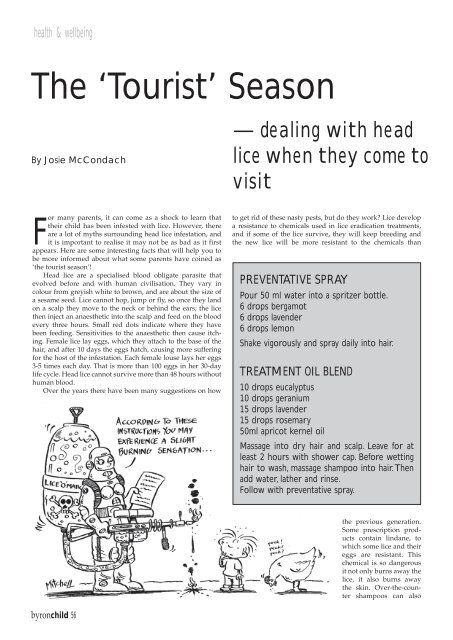byronchild - logo
byronchild - logo
byronchild - logo
You also want an ePaper? Increase the reach of your titles
YUMPU automatically turns print PDFs into web optimized ePapers that Google loves.
health & wellbeing<br />
The ‘Tourist’ Season<br />
By Josie McCondach<br />
For many parents, it can come as a shock to learn that<br />
their child has been infested with lice. However, there<br />
are a lot of myths surrounding head lice infestation, and<br />
it is important to realise it may not be as bad as it first<br />
appears. Here are some interesting facts that will help you to<br />
be more informed about what some parents have coined as<br />
‘the tourist season’!<br />
Head lice are a specialised blood obligate parasite that<br />
evolved before and with human civilisation. They vary in<br />
colour from greyish white to brown, and are about the size of<br />
a sesame seed. Lice cannot hop, jump or fly, so once they land<br />
on a scalp they move to the neck or behind the ears; the lice<br />
then inject an anaesthetic into the scalp and feed on the blood<br />
every three hours. Small red dots indicate where they have<br />
been feeding. Sensitivities to the anaesthetic then cause itching.<br />
Female lice lay eggs, which they attach to the base of the<br />
hair, and after 10 days the eggs hatch, causing more suffering<br />
for the host of the infestation. Each female louse lays her eggs<br />
3-5 times each day. That is more than 100 eggs in her 30-day<br />
life cycle. Head lice cannot survive more than 48 hours without<br />
human blood.<br />
Over the years there have been many suggestions on how<br />
<strong>byronchild</strong> 56<br />
— dealing with head<br />
lice when they come to<br />
visit<br />
to get rid of these nasty pests, but do they work? Lice develop<br />
a resistance to chemicals used in lice eradication treatments,<br />
and if some of the lice survive, they will keep breeding and<br />
the new lice will be more resistant to the chemicals than<br />
PREVENTATIVE SPRAY<br />
Pour 50 ml water into a spritzer bottle.<br />
6 drops bergamot<br />
6 drops lavender<br />
6 drops lemon<br />
Shake vigorously and spray daily into hair.<br />
TREATMENT OIL BLEND<br />
10 drops eucalyptus<br />
10 drops geranium<br />
15 drops lavender<br />
15 drops rosemary<br />
50ml apricot kernel oil<br />
Massage into dry hair and scalp. Leave for at<br />
least 2 hours with shower cap. Before wetting<br />
hair to wash, massage shampoo into hair. Then<br />
add water, lather and rinse.<br />
Follow with preventative spray.<br />
the previous generation.<br />
Some prescription products<br />
contain lindane, to<br />
which some lice and their<br />
eggs are resistant. This<br />
chemical is so dangerous<br />
it not only burns away the<br />
lice, it also burns away<br />
the skin. Over-the-counter<br />
shampoos can also


